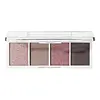What's inside
What's inside
 Key Ingredients
Key Ingredients

 Benefits
Benefits

 Concerns
Concerns

 Ingredients Side-by-side
Ingredients Side-by-side

Mica
Cosmetic ColorantTalc
AbrasiveSynthetic Fluorphlogopite
Caprylic/Capric Triglyceride
MaskingBoron Nitride
AbsorbentSilica
AbrasiveMagnesium Stearate
Cosmetic ColorantMagnesium Palmitate
Tridecyl Trimellitate
EmollientNylon-12
Magnesium Myristate
Dimethicone
EmollientBis-Diglyceryl Polyacyladipate-1
EmollientPhenyl Trimethicone
Skin ConditioningPolyisobutene
Phenoxyethanol
PreservativeCaprylyl Glycol
EmollientTriethoxycaprylylsilane
Tin Oxide
AbrasiveCI 77499
Cosmetic ColorantCI 77491
Cosmetic ColorantCI 77891
Cosmetic ColorantCI 77742
Cosmetic ColorantCI 77492
Cosmetic ColorantMica, Talc, Synthetic Fluorphlogopite, Caprylic/Capric Triglyceride, Boron Nitride, Silica, Magnesium Stearate, Magnesium Palmitate, Tridecyl Trimellitate, Nylon-12, Magnesium Myristate, Dimethicone, Bis-Diglyceryl Polyacyladipate-1, Phenyl Trimethicone, Polyisobutene, Phenoxyethanol, Caprylyl Glycol, Triethoxycaprylylsilane, Tin Oxide, CI 77499, CI 77491, CI 77891, CI 77742, CI 77492
 Reviews
Reviews

Ingredients Explained
These ingredients are found in both products.
Ingredients higher up in an ingredient list are typically present in a larger amount.
This ingredient is used to add a violet color to cosmetics.
It is created by reacting phosphoric acid, ammonium dihydrogen orthophosphate, and manganese dioxide.
Magnesium Stearate is a salt that is 2 parts stearic acid and 1 part magnesium.
It is a white powder that can be used to add bulk and color to products by binding to oil ingredients.
Mica is a naturally occurring mineral used to add shimmer and color in cosmetics. It can also help improve the texture of a product or give it an opaque, white/silver color.
Serecite is the name for very fine but ragged grains of mica.
This ingredient is often coated with metal oxides like titanium dioxide. Trace amounts of heavy metals may be found in mica, but these metals are not harmful in our personal products.
Mica has been used since prehistoric times throughout the world. Ancient Egyptian, Indian, Greek, Roman, Aztec, and Chinese civilizations have used mica.
Learn more about MicaTalc is a clay mineral. It helps absorb moisture and improve the texture of products. Like other types of clay, Talc can have a slight exfoliating effect on skin. Talc can be added to increase the volume of products.
Some Baby powders are made by combining talc with corn starch. The word "talc" comes from Latin and originates from Arabic. Talc is a mineral commonly found throughout the world.
If you have any concerns about using talc, we recommend checking out the FDA's official page.
Learn more about Talc